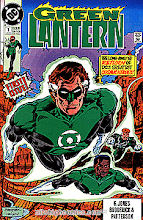Green Lantern/Green Arrow by Denny O'Neil and Neal Adams





This book marks a turning point of sorts for DC Comics. Since revitalizing the superhero genre in the late 50's and early 60's, DC played catch up to their innovative competitor Marvel Comics. Being the old hand, DC was less open to change and began to pay the price for it at the...umm...newsstands. As Marvel heroes gained popularity due to their "flawed" heroes and "realistic" stories, DC's prim and proper perfect heroes lost popularity.
To compete DC would have to change.
Enter in one of the titles that DC had revitalized the genre with, Green Lantern. Following the adventures of test pilot Hal Jordan who inherits an alien power ring that can create an energy field into any shape he can imagine. He becomes part of an intergalactic peacekeeping organization. Sagging in sales and with long time artist Gil Kane leaving, it was headed for cancellation. A perfect (and frequent back then) opportunity to experiment.
DC handed the title over to Denny O'Neil who had some success on Justice League Of America and Beware the Creeper (created and drawn by Steve Ditko). O'Neil had made some dramatic changes to other characters recently. He had stripped Wonder Woman of her Amazon powers and turned her into an Emma Peel type super-spy complete with "mod" new outfits. O'Neil also had turned Green Arrow from a bored millionaire who moonlit as a superhero to a champion of the forgotten and oppressed by having Oliver Queen (GA) lose his inherited millions. This last change would directly influence the Green Lantern title.
While O'Neil had reworked Green Arrow's character, artist Neal Adams had revamped his costume to fit a gritty urban Robin Hood in the pages of The Brave And The Bold. Adams had previously been teamed with Roy Thomas on the also soon to be canceled X-Men title (it went into reprints instead) at Marvel and had followed Carmine Infantino on Deadman for DC.
O'Neil decided that Hal had been in space so long that he had forgotten what it was like to be on Earth. The now liberal outspoken Green Arrow would make a nice foil for the conservative spacecop GL on his quest to reconnect with the common man. Added into the mix would be one of the Guardians (the GL's bosses) themselves to give a totally alien perspective. This quest would take the trio (and Black Canary who joins up with them) through America's west and on to other planets, all the while exploring many social issues that are still relevant today.
Race, overpopulation, pollution, cults, religious fundamentalists and drug addiction are just some of the topics O'Neil addressed.
One of the most famous comic covers and stories was the two issue arc in which Green Arrow discovers that his ward and partner, Speedy (ironic?), has turned to drugs and become a heroin addict. Following the Spider-Man story that involved generic "pills" that was printed without the Comic Code Authority seal, it was the first to come out and name a specific drug. Not only is the story about the effects of drugs, but the toll and consequences of addiction.

The second biggest event in the run was the creation of the John Stewart character. With the reserve GL Guy Gardner in a coma, the Guardians tell Hal Jordan to find another. The ring selects an activist and "angry black man" John Stewart. Initially adverse to the idea of serving the "Man" he realizes that he can accomplish a lot with the power of the Green Lantern. John Stewart would go on to become a big part of the Green Lantern mythos. He became the Green Lantern of the Justice League/Justice League Unlimited TV series.

O'Neil and Adams followed their run on GL/GA to a backup feature in the Flash and later teamed up for DC again for their famous run on Batman introducing Ra's Al Ghul and Talia. Adams had a run on the Avengers during the Kree/Skrull War and did many covers for both DC and Marvel. Adams also was instrumental in broadening creator rights. O'Neil became the editor of the Bat titles for most of the eighties.
The run was reprinted in the late eighties as a mini series that had new cover art by Adams on high quality paper. In 2000, DC came out with a hardcover complete with slipcase featuring all new coloring for the art. This in part led to the Adams Batman and Deadman runs being collected in to similar hardcover volumes.





No comments:
Post a Comment